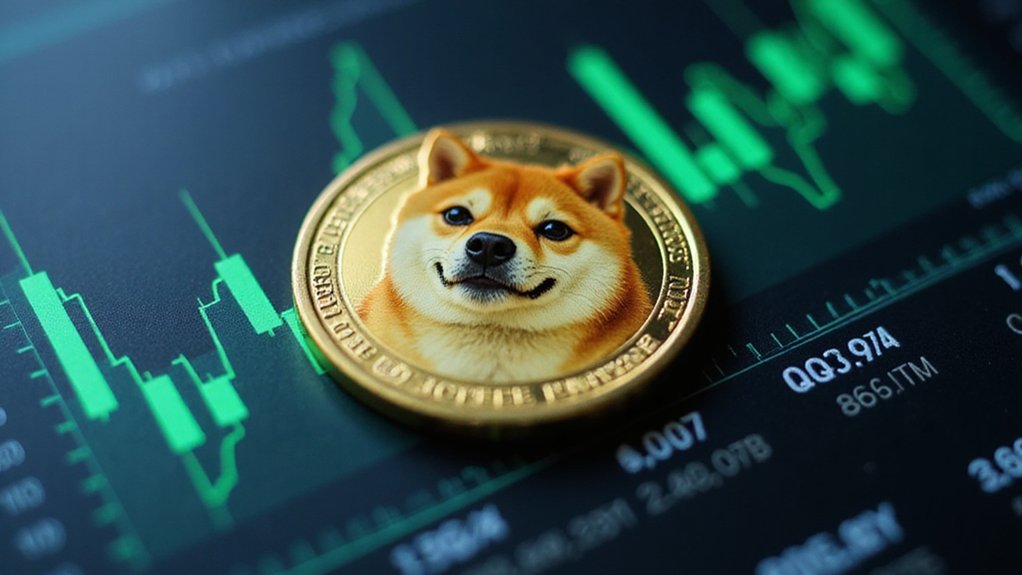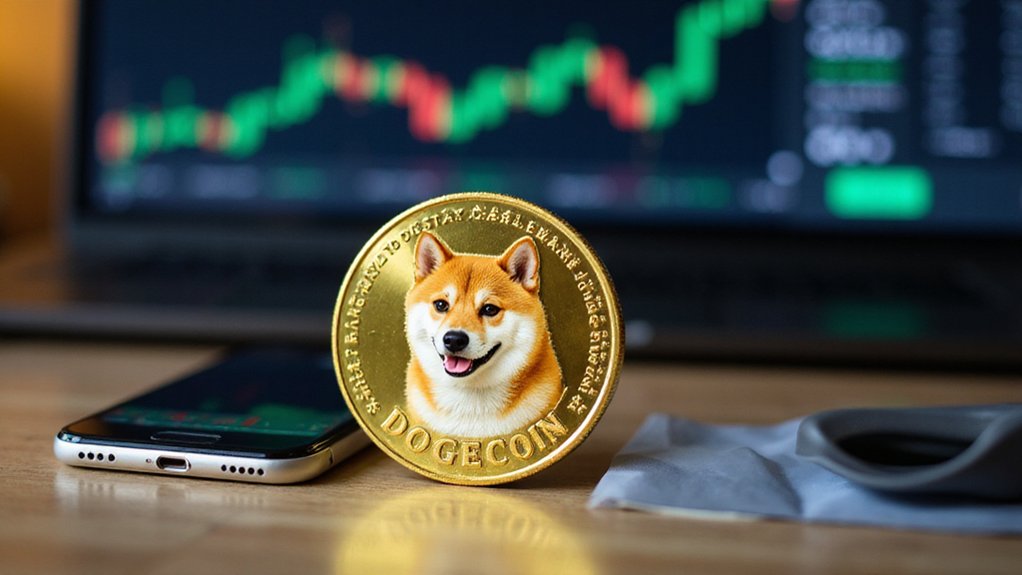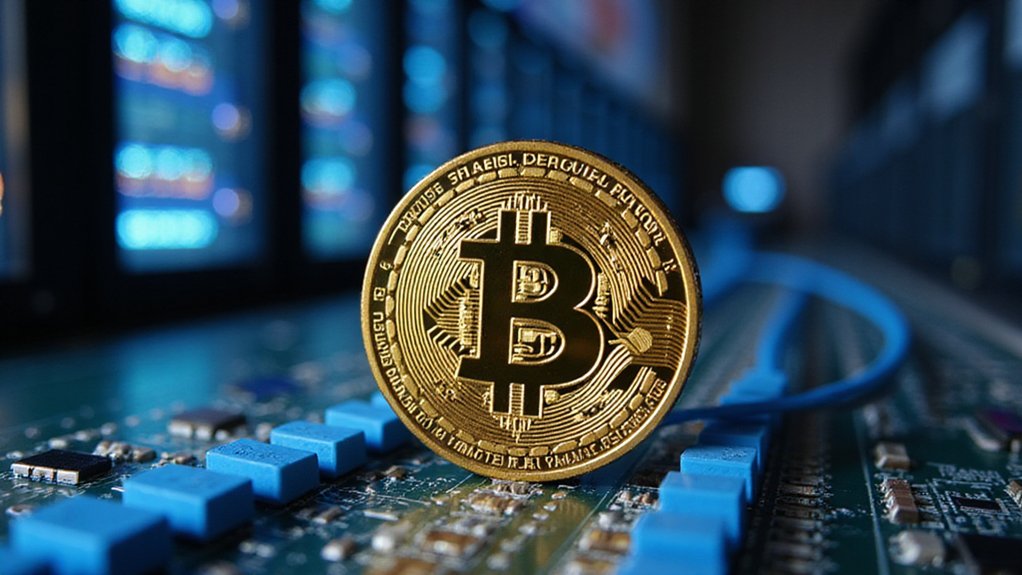Dogecoin emerged in 2013 as a satirical cryptocurrency featuring the Shiba Inu “Doge” meme, yet improbably transformed into a legitimate digital asset with an $85 billion peak market cap. Built on Litecoin technology, it processes transactions faster than Bitcoin while maintaining an intentionally inflationary supply model. The “Doge Army” community combines philanthropy with meme culture, attracting celebrity endorsements—particularly from Elon Musk—which has secured its adoption by mainstream retailers. This whimsical currency’s journey offers surprising lessons in financial evolution.

How did an internet joke transform into one of the world’s most recognized digital currencies?
Dogecoin’s metamorphosis from meme to monetary force exemplifies the unpredictable alchemy of internet culture and financial innovation.
In December 2013, software engineers Billy Markus and Jackson Palmer created Dogecoin as a satirical response to cryptocurrency speculation, featuring the iconic Shiba Inu “Doge” meme as its mascot.
This whimsical beginning belies its current status—a digital asset with a market capitalization that has, at times, exceeded $85 billion, placing it among the top ten cryptocurrencies globally.
Technologically, Dogecoin operates on principles borrowed from Litecoin (itself a Bitcoin derivative), utilizing the Scrypt hashing algorithm within a Proof-of-Work consensus mechanism.
Transactions are verified and recorded on a decentralized blockchain, with new blocks generated approximately every minute—considerably faster than Bitcoin’s ten-minute interval.
This efficiency facilitates quicker transaction confirmations, though certainly not at the expense of security that more contemporary protocols might offer.
Unlike Bitcoin’s capped supply of 21 million coins, Dogecoin embraces an inflationary model with no maximum limit.
The blockchain mints 10,000 new DOGE with each block, translating to roughly 5 billion additional coins annually—a feature that economists might view with raised eyebrows when considering long-term value propositions.
Currently, Dogecoin has a circulating supply of approximately 148 billion DOGE, reflecting its intentionally abundant design philosophy.
The “Doge Army,” as its community calls itself, has cultivated a reputation for philanthropy and lightheartedness.
They’ve funded charitable initiatives ranging from the Jamaican bobsled team to clean water projects, creating a peculiar juxtaposition: a joke currency financing genuine social good.
This community ethos, coupled with celebrity endorsements (notably from Elon Musk), has propelled Dogecoin beyond mere speculation into selective mainstream acceptance.
Major retailers including AMC Entertainment and the Dallas Mavericks now accept DOGE as payment, with the latter recording over 20,000 transactions in March 2021 alone, while its primary utility remains digital tipping and micropayments across social platforms.
The cryptocurrency was officially listed on Binance exchange in summer 2019, significantly expanding its accessibility to global investors and contributing to its growing legitimacy in the cryptocurrency ecosystem.
The cryptocurrency’s journey—from satirical comment on financial speculation to legitimate financial instrument—represents perhaps the most curious footnote in modern monetary evolution: when the punchline becomes the point.
Frequently Asked Questions
How Do I Buy Dogecoins?
To buy Dogecoin, one must select a reputable cryptocurrency exchange (Coinbase, Binance, Kraken) or broker (Robinhood, eToro).
After creating an account—complete with the requisite KYC verification—funds can be deposited via bank transfer or card payment.
Navigate to DOGE’s trading pair, specify the desired purchase amount, and execute the order.
Post-purchase, coins may remain on the exchange or migrate to a personal wallet (hardware or software) for enhanced security—a prudent consideration given crypto’s notorious volatility.
Is Dogecoin a Good Investment?
Dogecoin’s investment profile exemplifies high-risk speculation rather than sound financial strategy.
Its meteoric rises (and subsequent plunges) reflect its dependence on social media sentiment and celebrity endorsements rather than fundamental value propositions.
The unlimited supply model creates inherent inflationary pressure, while its utility remains limited compared to leading cryptocurrencies.
Though potentially lucrative for short-term traders with iron stomachs, long-term investors might find the proposition akin to casino gambling rather than portfolio building.
What’s the Maximum Supply of Dogecoin?
Dogecoin has no maximum supply limit—a feature that fundamentally separates it from scarcity-driven cryptocurrencies like Bitcoin.
After removing its initial 100 billion coin cap in 2014, Dogecoin embraced perpetual inflation, adding approximately 5 billion coins annually through its fixed 10,000 DOGE block rewards.
This deliberate inflationary design (somewhat unconventional in the “digital gold” narrative dominating crypto) theoretically encourages actual spending rather than speculative hoarding, though it naturally constrains its potential as a long-term value reserve.
Who Created Dogecoin and Why?
Dogecoin was created in 2013 by software engineers Billy Markus (IBM) and Jackson Palmer (Adobe) as a satirical response to cryptocurrency speculation.
The pair—who remarkably coded the project in mere hours—intended it as a lighthearted alternative to Bitcoin, leveraging the popular Shiba Inu “Doge” meme for accessible appeal.
Unlike its predecessors with finite supplies, Dogecoin was deliberately designed with unlimited issuance, underscoring its origins as a playful commentary rather than a serious investment vehicle.
How Does Dogecoin Mining Work?
Dogecoin mining employs a Proof-of-Work mechanism using the Scrypt algorithm—less resource-intensive than Bitcoin’s SHA-256.
Miners compete to solve cryptographic puzzles, with successful validators receiving 10,000 DOGE per block (minted approximately every minute).
Participants can mine solo (infrequent but full rewards), join pools (consistent smaller payouts), or utilize cloud services.
While originally GPU-friendly, the ecosystem now favors ASIC hardware—specialized devices delivering superior hash rates despite their considerable power consumption.









